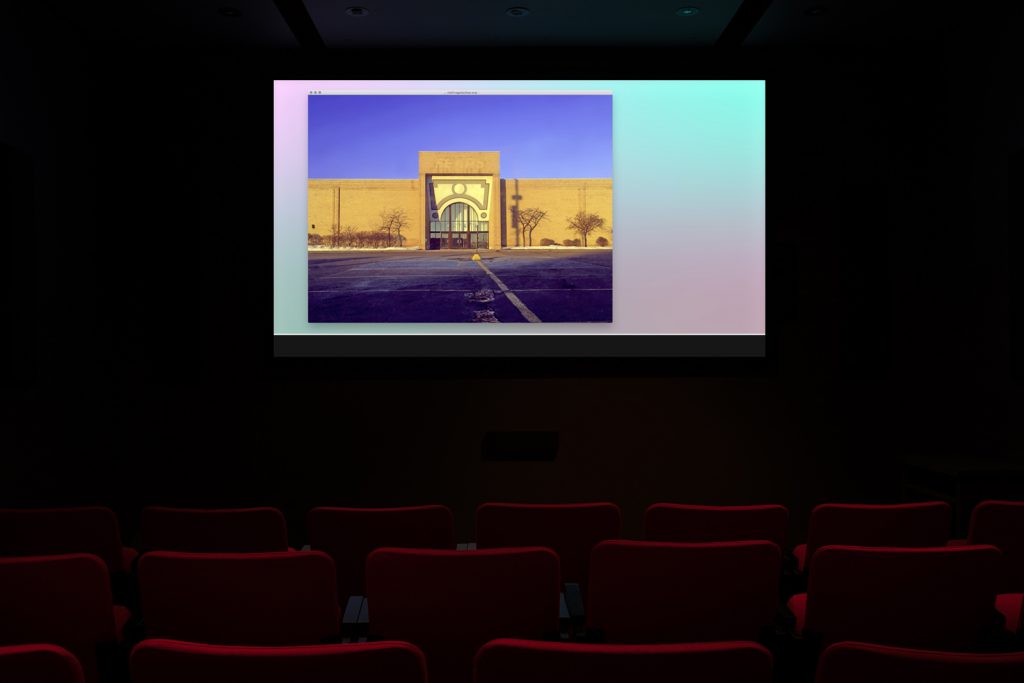Vague Appropriation
26 September 2020
By Michael Eddy
“If I want to imagine a fictive nation, I can give it an invented name, treat it declaratively as a novelistic object, create a new Garabagne, so as to compromise no real country by my fantasy (although it is then the fantasy itself I compromise by the signs of literature). I can also—though in no way claiming to represent or to analyze reality itself (these being the major gestures of Western discourse)—isolate somewhere in the world (faraway) a certain number of features (a term employed in linguistics), and out of these features deliberately form a system. It is this system which I shall call: Japan.”
– Roland Barthes, Empire of Signs
It has been said that vagueness reinforces beliefs by treating them as “patently evident” and “acritically indubitable.” (1) While that sounds right in rhetorical contexts, it is awkward to apply such logic to artworks. In the context of visual art, a different definition of vague would be helpful, something other than the merely cloudy, inadequate or even lethargic; there is a subtle velocity to vagueness that artists hitch onto. Colloquially speaking, we don’t know what to look at in a vague photograph. A vague painting sounds like something hard to recognize, both in terms of what is portrayed and what genre or discourse a representation belongs to. Vagueness as a description of an artist’s practice as a whole might be better conceptualized as elusiveness, because the unfixed ways of working that come to mind in fact challenge our expectations of the figure of an artist. Vagueness in art, in short, would seem to entail a difficulty in identification. (2)
Meanwhile, an appropriation can only be the identity of another thing—there must be an element of identification in order for an appropriation to qualify as such. And in order to be an appropriation and not just a reference—or, even more removed, an allegory—the identity needs to be somewhat more whole. These discussions on a formal level can easily slip into generalities, but at least they can hint at identity being an aspect inherent to the history of appropriation art—and not necessarily in the sense taken up by identity politics and post-colonial theory, which has come to characterize recent discussions of appropriation, where “[t]he very forms of artistic trespass that once seemed to guarantee the radicalism of a given practice — the way appropriation promised a form of emancipatory redistribution of cultural property — now stand for a sort of arrogant imperialism[…].” (3)
What does it mean to consider the push and pull of the terms vague and appropriation, when paired? The idea that this coupling would be in the service of a more acceptable (because clandestine) license for cultural appropriation is certainly not appealing. The point isn’t to figure out what one can “get away with.” However, in spite of the typically corrosive and reactionary replies in the name of free speech to charges of cultural appropriation, there is also a sense that refusing to negotiate these terms reduces the potential room for maneuver and nuance for culture at large, and every practitioner within it.
Or is it better to let culture break into irreconcilable fragments? Even then, those fragments have edges, and we wonder, how sharp are those edges? This is why vagueness emerges. Vagueness is not a homogeneous quality, and its reaction with appropriation can result in a spectrum of effects. On the end closest to overtness, where identities are clearly distinct or even flat, the meaning of an appropriation is still subject to one’s knowledge of the references, and so irony can play a decisive role. On the other end of the spectrum would lie unidentifiability, which shares a border with opaqueness. When the opaque aspect is mapped onto appropriation, it can appear as inscrutability, where no intention can be ascertained. Or, paradoxically, it could even appear as a kind of transparency, with the act of taking downplayed to the point of plagiarism.
Do appropriations gone vague generate room for maneuver? Or how much does vagueness simply reflect the identities of today, hybridized by history, economics, technology and culture itself?
Montreal-based artist Douglas Moffat’s recent video #mallsoft: Reflections On A Dead Genre (2019) navigates several layers of simulation, while on its face it appears as a straightforward presentation of information. (4) With what feels like the starkness of a readymade, the video consists of a “real-time” primer on mallsoft, a sub-genre of vaporwave music. The video’s visual field resembles a computer desktop with a backdrop of fuzzy, gradually altering colours. An audio app embedded on the bottom plays full-length mallsoft tracks as pop-up windows periodically display album covers, background information on artists, related instagram rolls, e-book excerpts or snippets from youtube. Cursors gently make selections and browse for us, like helpful fairies. This is also the way we shop today. Mallsoft music, appropriately, is an audio simulation of physical shopping malls as they existed in something like the Seventies and Eighties: muzak and ambient sounds echoing in cathedral-like spaces where we acoustically linger for a dozen minutes. Moffat points directly to echoes through several references, framing them as historical processes as much as audio effects which seem to automatically age everything.
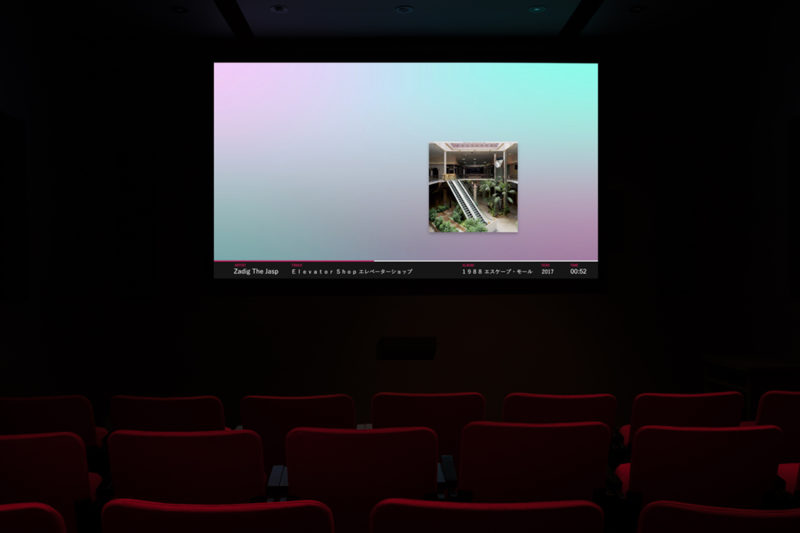
The echo of once-futuristic decades (by artists who mostly appear too young to have any direct memories of them) is what ties mallsoft to vaporwave—both microgenres draw their aesthetics heavily from the 1980s, in particular a Japanese boom-economy music style known as city pop. The meaning of Japan for mallsoft creators, who borrow audio samples, names and covers from Japanese consumer culture—while seldom being Japanese, per my inquiries into the backgrounds of this pseudonym-loving gathering—goes unremarked by Moffat. Video games and manga, in some sense an online lingua franca for younger generations, explain some of the fascination. Fan culture, moreover, has evolved today into a space where the line between ironic treatment and heartfelt attachment is itself blurry. Moffat’s role as affectless presenter of these compositions likewise mirrors such blurriness. Rather than judging the appropriateness of these faraway cultural references, Moffat connects the emergence of these musical microgenres in the 2010s with the collapse of shopping malls as a cultural force and their literal disappearance as physical environments.
Through one pop-up window late in the video, we see the pioneering house DJ Derrick May touring Detroit’s old Michigan Theatre in a documentary clip. The regal building had been the centre of house music in the 1980s, but by the 1990s, having fallen into severe disrepair, it was converted to a parking garage. This reminds us how the present is part of successive waves of collapse, with specific cultures nurtured in the ruins. Why, on the other hand, should we grieve for shopping malls, their engineered comforting ambiance, their disavowal of the external world? What are the equivalent cultural byproducts worth redeeming from the rubble of Sears and Target?
The figure of death hovers nearby in an earlier project also arising from the margins of fan culture, the Pierre Huyghe- and Philippe Parreno-initiated project No Ghost Just a Shell. The story starts in 1998 with the pair purchasing rights to a downmarket manga character they named “Annlee.” (5) This character was offered to a cohort of 18 artists who produced about 28 artworks with it. With the help of a lawyer, Huyghe and Parreno famously transferred the character’s image rights to an entity named for the character (the ANNLEE company), and finally “killed” the character in 2003.
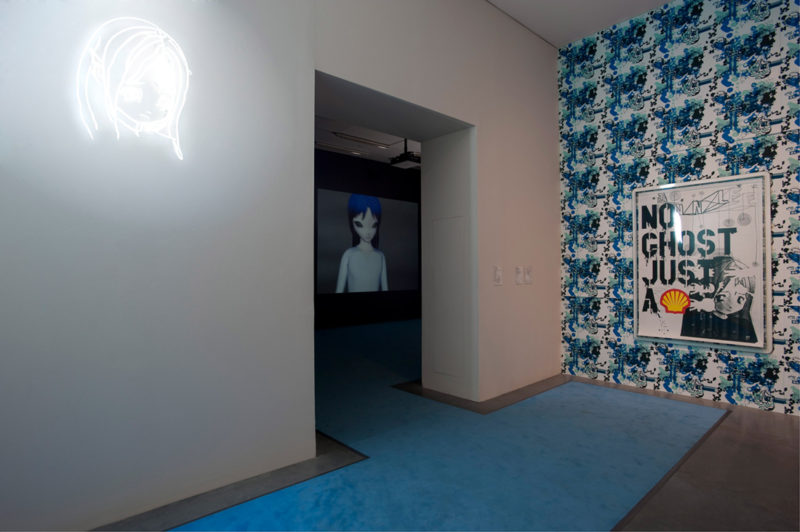
Through the collection of their works Huyghe, Parreno & co. advanced an interpretation of this character as the signifier of a homeless subjectivity, a multi-authored and unfixed entity saved from the determinacy of the entertainment market that would have doomed it to a quick and near-anonymous annihilation. Before it was laid to rest, the narratives had the character living most of this twilight state wondering about its own consciousness, animated against blurry non-place surroundings, altering in appearance slightly because it was allowed to.
This virtual nobody was an ambivalent star for a couple years. Issues related to appropriation and authorship crop up at several junctures. Firstly, although the use of the character could be legitimated on the grounds that it was sanctioned by a sales contract, its recontextualizing away from commercial applications involved a certain degree of revaluation of the image, in ways similar to 1980s appropriation practices like those of Richard Prince and Jeff Koons. Secondly, from a narrow art world viewpoint, the multi-authored, networked project asks its own questions about copyright and authorship (like how were the proceeds of sales split up, who was attributed with each showing, etc.), complicating and either dissipating or inflating the issue of intellectual property. Finally, constructing a legal persona, a company that could receive the image rights of the character, hypothetically meant that further use of that intellectual property would have been a form of appropriation against the rights of the character itself.
As a networked and narrativized update to appropriation art, the naked act of taking is thereby smudged, and ventriloquism turns into a conversation. However, the specificities of the character emerge again and again in discussions around the project. The vagueness of what this “deviant signifier” (a shell) meant for various people was regularly tied to gender—the artists referred to the character consistently as a she, and even as a virgin, and this has effects on the rhetoric of emancipation of the sign. “She’s just floating out there in the middle of nowhere waiting to attach herself to someone else.” (6) Tropes of the damsel in distress and the white saviour come into focus: “[The artists] establish themselves as Annlee’s originators, liberators and fathers. They gave birth to Annlee, and they ultimately know what is best for ‘her.’” (7) Furthermore, the character’s origins in Japan can’t be so easily written off as unrelated to the meaning of the project—though they are written off in the book documenting the project, where the topic of cultural clichés is mentioned just once, only to be rejected.
However, even if their project was a more analytic examination of narrative structure and the empty heart of signs in general (that is, free from any specific culture), the economics of the animation industry have been described as the contextualizing “storyrealm” (8) that would render the work that much more complex. The tangled associations of the manga industry, science fiction narratives and legal and copy rights regimes dragged along with the character Annlee, in other words, are crucial to what makes the project as a whole compelling. The artists’ insistence on vague origins haunts the ethical dimension of appropriation and copyright that the project otherwise stirs up. (9)
In the cases of both #mallsoft: Reflections On A Dead Genre and No Ghost Just a Shell, a cultural artifact is recontextualized from its origin as distributed media into a contemporary art setting. Similarly, Raymond Boisjoly’s work perches on such a shift in context. Through his use of language and through images flatbed-scanned from lcd monitors like iPads (among other conceptually-guided and photographically-minded practices), he focuses on what happens in the reception of a transmission. A complex mix of factors contributes to the reading of his images and texts, not least of which is Boisjoly’s Indigenous identity. As he has exhibited principally “for audiences that are predominantly non-Indigenous,” the history of how images of Indigenous communities are received and categorized by non-Indigenous and colonial populations forms a keen backdrop. (10) Boisjoly’s work not only brings this inquiry to the technological present by referencing the increased rate and pace of access to images and representations by way of screens and video platforms, it also arrests the seamless flow of moving images and languages, resulting in the codec’s breakdown. Rather than providing a corrective to given representations and mis-categorizations, Boisjoly leaves exposed the grammar of their momentum and positions himself openly as a fellow reader.
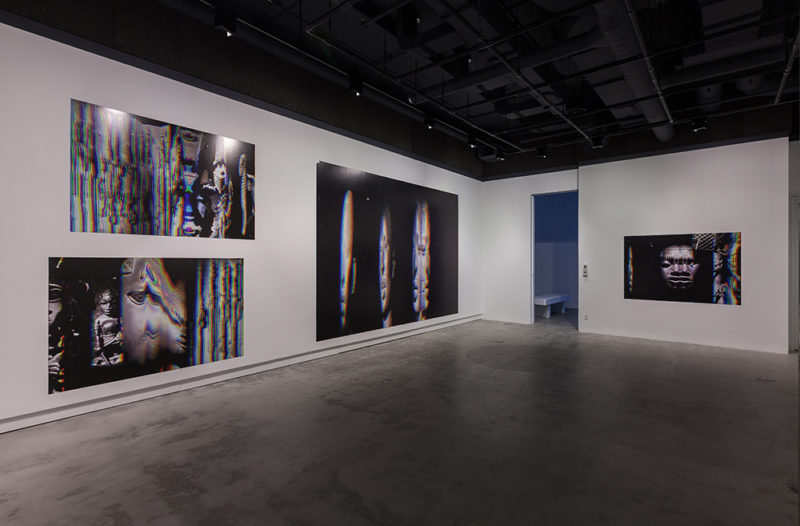
Boisjoly’s 2015 installation at Vox centre in Montreal, From age to age, as its shape slowly unravelled… featured a number of large scale prints adhered to the walls. The images were obviously taken from an ethnographic museum display of some sort, where masks, busts and sculptures from non-Western cultures were isolated but also assembled in a baffling shadow space. Boisjoly’s screen scanning technique results in characteristic colour separation at certain points, and at others in a visual melting of features and striking cuts that index the montage of his video source. The latter was Statues Also Die, a 1953 film by Chris Marker and Alain Resnais ruminating on the absurdity of colonial collections of African objects. Boisjoly’s prints registered as neither a critique nor a celebration of this film, but as a reflection of “what is lost and what is gained in the act of appropriation.” (11)
The video in an adjacent room, greyscale.mp4 (2015), is a slideshow of grey text on differing grey backgrounds—but the messages they point to are also somehow grey in meaning. There is no master subtitle within this arrangement of works that would provide an authoritative reading. If his works haven’t been called vague, they elicit a cluster of synonyms for what we have been talking about here: evanescent, ambivalent, floating in suspension, uncertain, undecidable, lacking fixity, indifferent, deferred, noisy, encrypted. (12) Vagueness in these appropriations refers to a middle zone of openness about the construction of images and history, where we find ourselves, where our languages are all inadequate but hold pragmatic potential. Vagueness as vagrancy, literally rambling in time and space over the representation, and not vagueness as sitting in mist. One more piece by Boisjoly should be described so that we don’t simply feel that this is a zone of comfort. A pair of images called (D’Angelo (Interval: 2000/2013) Untitled (How Does It Feel) (2013) were appropriated from D’Angelo’s breakout music video “How Does it Feel,” which solidified the apparently introverted R&B singer as an unlikely sex symbol, a self-image that would haunt him during his subsequent career. Boisjoly’s scrambling of two moments from the video could be seen as disfiguring the Black man’s body—or freeing it from the typecast role the music industry had assigned to it. I doubt this is a distinction that Boisjoly makes easily: even as issues of representation may be common to different groups of racialized people, there is an indeterminate but real gradient of power and difference that precludes anything like a “license” to use images on behalf of another. It is certain Boisjoly understands this and is not resting on a claim to freedom of expression. But also certain is the fraught space these beautiful, ugly images set up.
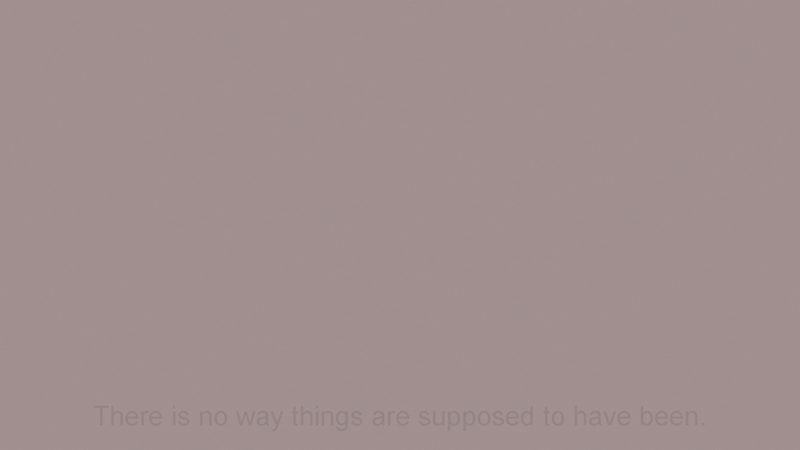
If the vague familiarity of mallsoft can tend heavily toward ironic reference, and the vague defamiliarizing of Annlee can disavow the possible real-world implications of a reference, is it grasping to find in Boisjoly’s dispossessed codes any hope for vagueness to decouple appropriation from its more sinister connotations? I did not set out in writing this text to argue for more vagueness in appropriation, or to say there is a good way and a bad way to be vague, or that it is new. Hints of what we are talking about here can be found even in the more canonized appropriation art of the 1980s: in the punctum of Louise Lawler’s settings, in Sherrie Levine’s painterly translations, in the hard-to-place quotations in Cindy Sherman’s portraits, all of which cause the mind to wander beyond sources and signs. Some see in the dedication to appropriated objects an effect on the appropriating subjects, which in turn suggests a surplus in objects that undermines widely held beliefs in the instrumentalizing, critical power of appropriation. (13) Artists can get lost and lose control in objects, which also means they can explore and reconfigure them. It is evident from the works above that vagueness can change the contours, and even enlarge the world beyond the immediate, the physical, the linguistic, the human. A distinction in the work I have described is the cross-cultural thematic, which is also nothing new considering the roots of modernist art, as well as where appropriation art turns more toward institutional critique (e.g., Fred Wilson). Subject and identity positions, however, have never been more prominent, so in a discussion around appropriation and its relation to cultural appropriation, being vague comes with tangible risks. Vague appropriation can be a means to fight against essentialism, but it can also be used to cloak identity. Real, existing power imbalances do have consequences for the opacity or overtness involved in an appropriation, which points to the need not for what some call “censorship” but for a degree of self-reflexivity at every point on the spectrum.
The ambivalent conclusion above doesn’t mean that labels would eliminate all risk, as the unstable relation of signs and identities demands contextual and case by case interpretation. A final greasing should be given to irony, then, as it remains the squeakiest wheel on the vague train.
Ironic encore
The question of what utility vagueness could have in loosening the stringent terms of appropriation in fact arrived to me by way of irony. Specifically, from my vantage point on the mezzanine level at Le National, a Belle Époque-era theatre venue in Montreal’s Gay Village, where I was observing a cluster of young people down below. They danced rapturously to John Maus singing his greatest hits as he physically beat himself up onstage. Maus’ seeming compulsion to tear at his shirt, smack his head and chest and violently crank his upper body up and down felt at odds with the sounds he was making. Heavily applied delay effect gave the impression Maus was poorly lip-syncing his lyrics, which echoed in and out against the compositions. I found myself thinking of the interviews I had seen in which Maus espouses his aspiration of truth in music and questions labels like “hypnagogic pop” that attempt to describe musicians like him. (14) And yet the self-abuse and exertion we enjoyed seemed like the only logical outcome of an encounter between irony and sincerity. When what can still be called a nostalgic sound—comfortingly familiar but located just beyond the reach of memory—rubs up against the authentic emotional presence Maus seeks to create through his corporal punishment (which, it must be added, Maus repeats almost every show), the extremities poke out.
In Retromania the music critic Simon Reynolds outlines the recent epidemic of remakes across large sections of the pop music world. Some symptoms include reunions and reissues, outpourings of cover versions, remixes or sampling, but some of the production has been less transparent in its references, as exemplified by the British microgenre “hauntology” and “the amorphous genre known variously as chillwave, glo-fi and hypnagogic pop.” (15) While Reynolds points to the contemporaneousness of sampling technologies in music with the appearance of appropriation art, he associates the advent of the above categories with the internet and seemingly infinite access to materials that may have once been obscure or guarded. The retro phenomenon, his book maintains, is formed of a loss of belief in the future, a land of recycling clouded by a fog of irony. (16)
As I mentioned, in its more overt manifestations vague appropriation can make irony happen. It is worth bearing on this particular aspect for a moment, as irony has an addictive, toxic and hugely influential footprint today in culture and entertainment, in politics and especially in social media, as well as in how these fields are braided together. The effectiveness of the dog whistle, for instance, is that for certain sections of the audience the message is passed over as vague or diffuse, while others receive a clear call. In our less centralized time, the whistle alters into memes churned out as mollifying bait for the most disgusting political positions on the spectrum. The ironic and the nostalgic can sometimes loop around and awkwardly, greedily clasp hands, as in the hyper contradictions of the alt-right phenomenon: homophobic gay shock jocks, racist jewish Western chauvinists, anti-feminist female leaders, hipsters-cum-conservatives. The scrambled signals can be hard to read. (Such a misreading involving John Maus resulted in his 2016 appearance on a late night cable show later cancelled for its creator’s alt-right blend of racism, homophobia and misogyny. Who read whom wrong?)
As Linda Hutcheon has said, irony is also “trans-ideological”—indeed its ambiguity is what makes it so dangerous. In her work she is careful to chart the diverse claims made for it by everyone from elites to minorities: “Most recently, it is feminist, postcolonial, gay and lesbian theorists who have argued this position in different but related ways [i.e., they see irony as a powerful tool or even weapon in the fight against a dominant authority]. The contrasting view of irony as negating, as largely destructive, appears to be held, at different times, by almost anyone who has been on the receiving end of an ironic attack (or missed the irony completely). […] But again, the affirmative and the destructive political functions cannot really be separated one from the other because those who see irony as primarily destructive also tend to see it as totally complicitous—and thus hypocritically affirmative.” (17) This isn’t to say one way or the other whether the previous artworks have any horses in this race. But vague appropriation as a potential critical strategy of engagement with questions of identity brings these issues out naturally.
One could argue, like Maus above, that the antidote to irony is actually authenticity. If the self-reflexivity I called for above meant authentic presence, maybe we could indeed eliminate the risk of artificiality in the vague appropriation? In a performance of Jacob Wren’s recent book Authenticity is a feeling, which recounts the history of PME Art, the performance group he has headed for twenty years, Wren explained that his ultimate goal and what keeps him going is work that strips away the baroque theatricality of most performance art (like scripts, affectations, etc.). (18) It may be odd to finish this essay on an example that seems to eschew the scaled plating of appropriation for some type of biographical vulnerability. But while I found Wren’s performance affecting, I also could not help finding it affected. “In a way this echoed something that had followed us since the beginning of the show: when you are being yourself, when you are trying to bring more of this reality into the performance situation, so many people think that because it is still theatre, taking place onstage everything you’re saying must not be true. Or at least they come expecting fiction, and when it’s so unclear how the things you’re saying match or don’t match this expectation, they can easily become suspicious.” (19) In my suspicions of Wren’s call to “being yourself in a performance situation,” I display the ironic symptoms of so many people. But a few pages later, I get a sense of why I enjoy this suspicion, these symptoms: “I am rewriting history from the perspective of now, because non-fiction is always also a kind of fiction.” (20) Authenticity always also has a kernel of irony, not least when representation is involved. If we hope to find a more productive and just form of appropriation based on authenticity and sincerity, I have a hunch that scenes of self abuse would be necessary to make us feel possessed of our identities; or that dedication to a principle of opacity would firewall errant interpretation; or that it may not be appropriation after all.
1. C.S. Peirce’s terms, quoted in Chiasson, P. (2001). Peirce’s Logic of Vagueness. In M. Bergman & J. Queiroz (Eds.), The Commens Encyclopedia: The Digital Encyclopedia of Peirce Studies. New Edition. Pub. 121220-2109a. Retrieved from http://www.commens.org/encyclopedia/article/chiasson-phyllis-peirce%E2%80%99s-logic-vagueness.
2. See Megan Quigley, Modernist Fiction and Vagueness (Cambridge University Press: Cambridge, 2015).
3. Tom McDonough, ‘Raymond Boisjoly: The Antimonies of Appropriation’, OSMOS Magazine, Issue 14, Winter 2018; p.38.
4. On view April 18 to June 15, 2019 at Dazibao, Montreal. The credit says “prepared by Douglas Moffat.”
5. The purchase was apparently made from a company called Kworks, but I have been unable to find any online trace of this company existing now or when the purchase was made, except for in articles about No Ghost Just a Shell (where it is sometimes rendered as K works, or K-works). It is tempting to consider the consequences of what it might mean if the back story were an invention by the artists, but I will not speculate on that here.
6. Israel Rosenfield, No Ghost Just a Shell (Walther König, Cologne: 2003); p. 99.
7. Rachel M. Wolff, “We bought a virgin,” in Shift: Graduate Journal of Visual and Material Culture (Issue 4, 2011) accessed: http://shiftjournal.org/wp-content/uploads/2014/11/wolff.pdf
8. In folklore studies, “storyrealm” refers to the larger narrative and performative frame that then encompasses the “taleworld”—in this case the storyrealm is the context of the manga industry, and the taleworld is the story of purchasing the manga character. See: Amy J. Elias, “The Narrativity of Post-Convergent Media: No Ghost Just a Shell and Rirkrit Tiravanija’s ‘(ghost reader C.H.),’” SubStance #124, Vol. 40, no. 1, 2011 (Johns Hopkins University Press, Baltimore).
9. Chin-Chin Yap points out that an alternative approach more veritably destabilizing to the individual-focused rights regime would have been to open the character’s use further according to Creative Commons practices: http://www.artasiapacific.com/Magazine/77/EscapingGhost
10. Reid Shier, ‘Raymond Boisjoly’, Sobey Art Award 2017, National Gallery of Canada, 2017.
11. McDonough, p. 38.
12. These are all words used in an interview between Raymond Boisjoly and Sarah Robayo Sheridan. http://kofflerarts.org/publication/2016/05/17/raymond-boisjoly-over-a-distance-between-one-and-many/; accessed September 30, 2019.
13. See Isabelle Graw “Dedication Replacing Appropriation: Fascination, Subversion and Dispossession in Appropriation Art” in Louise Lawler and Others (Hatje Kantz, Berlin: 2004).
14. “The first time it was hypnagogic pop, and last time, I can’t remember, something like ’80s retro, and now I’m a retro-futurist. (…) I keep making this point that opposed to reflective judgment in relationship to people’s work, it’s a determinate judgment that takes place. Everybody has got a concept or genre at hand to affix to the work talking about as opposed to trying to reflect on what sorts of new concepts they can tease out of what they’re discussing. That would be ideal.” Accessed 22 July, 2019 at: http://beatroute.ca/2018/01/18/john-maus-makes-music-wrong-apocalypse/. A longer, more informed exposé of Maus’ music: https://medium.com/@impliedreader/mausterpiece-f3c3181a5ca4. Other artists referred to by this category include Ariel Pink, Molly Nilsson, James Ferraro and others.
15. Simon Reynolds, Retromania, Farrar, Strauss and Giroux (New York: 2011); p. 345.
16. “I’ve also written about ‘the cancer of irony’ that has metastasised its way through pop culture. Metastasis, the word for the spread of disease through the body, inadvertently pinpoints the malaise of postmodern pop: there is a profound connection between meta-ness (referentiality, copies of copies) and stasis (the sensation that pop history has come to a halt).”
17. Linda Hutcheon, Irony’s Edge: The theory and politics of irony (Routledge, London), 1994; p. 26.
18. Published by Book*hug Press (Toronto, 2018). The performance took place at La Chapel, Montreal in Spring 2019.
19. Wren, p. 52.
20. ibid. p. 59.
Feature Image: Still from #mallsoft: Reflections On A Dead Genre, 2019 by Douglas Moffat. Photo by Marilou Crispin courtesy of Dazibao.

